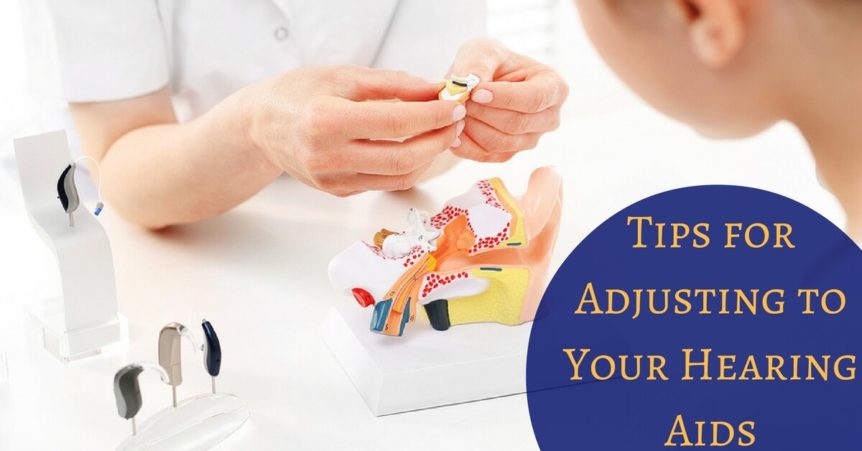Congratulations on your new hearing aids! Like everything unfamiliar, your device may take some getting used to, but hearing your best and reconnecting with loved ones makes it well worth the effort. It’s important for us at Neighborhood Hearing Center to make sure you are getting the most benefit and comfort from your hearing aids.
Most hearing loss is gradual and as that progressive loss has been occurring, your brain has been adapting to impaired hearing. Over time, the way you comprehend speech and process sound will have been changed in your brain to compensate for your hearing loss. With the use of a hearing aid, your brain may have to re-learn certain listening skills, especially speech recognition. This can make adjusting to hearing aids challenging at first, but with a little dedication and patience using your hearing aids will quickly become second nature.
Take it Slow and Steady
It’s okay to start your adjustment to your hearing aid slowly. Much like a new pair of glasses would take your eyes some getting used to, hearing aids can be disorienting at first. One of the keys to getting used to your new hearing device is consistent use. Your goal with your hearing aids will be to wear them your entire waking day.
Wearing a hearing aid may feel strange or awkward at first, but spend a little time getting used to the physical feeling of it resting in or on your ear and soon it’ll start feeling comfortable and natural.
Likewise, the new sound-scape a hearing aid provides you with may feel overwhelming at first. We recommend you start by just observing what you hear when you’re alone in a quiet place. Listening in a still environment will help you hear and normalize subtle sounds that may seem unfamiliar at first.
Commit to using your hearing aid for several hours each day and steadily increase that amount of time every day. Within a two-week period gradually ramp up the time you use your hearing aid until it is fully integrated into your everyday life. Lots of sounds will seem new or take a minute to adjust to, but the more you use your device the more familiar sounds will become.
Be Cautious With Volume and Adjustments
Your hearing aids have been custom programmed for you by our hearing specialists to maximize their effectiveness and comfort so at the very beginning, when you first start using your hearing aid, don’t fiddle with its volume or controls too drastically. There will be situations where small adjustments to your device will help you acclimate to a situation, but dramatically turning up your volume levels -especially to try to decipher sound that is overly soft or unintelligible to normal hearing- may result in hearing damage.
If you’re worried about the way your hearing aids are adjusted, start a list of the sounds and situations that seem troublesome. Keep using your hearing aids every day and play an active role in adapting to them. At the time of your first follow-up visit go over your list and if any of the sounds remain an annoyance, let your hearing specialist know. We’ll be happy to help you find the best fit or adjustment to your hearing solution and show you how to optimize its effectiveness in different types of sound environments.
Train Your Brain
One of the main challenges hearing aid users experience is being able to recognize speech. Hearing loss re-writes how we process speech and increases the effort it takes to comprehend it. Regaining or acquiring hearing ability with hearing aids can ease the strain of hearing effort, but it may take some practice to link sound to speech.
When you’re alone, a great exercise is to engage in media where you can read words while you hear them. This can be as simple as reading a book aloud to yourself or watching television with closed captioning. Another great technique is reading along with an audiobook. You may get some great entertainment, and all the while you’ll be teaching your brain to reconnect words to their sounds.
When you’re with friends and family, be sure to be an active part of the conversation. The voices most familiar to you will initially be the easiest for you to recognize. Pay attention to whoever is speaking and what they are saying. Be sure to speak up yourself! Believe it or not, you may even need a little time to recognize the sound of your own voice!
Take Advantage of Your Device’s Features
Hearing aids today are a technological marvel, tiny microcomputers personally fitted to help you experience your fullest sound palette.
Many device models feature telecoil technology that makes it possible to receive audio directly into your hearing aid. Public places like theaters, churches and airports often are equipped with induction loops which transmit audio to telecoil.
Another modern hearing aid feature is the capability to directly stream sound from “smart” devices. Check with your hearing specialist to see if your hearing aid has these wireless assistive capabilities, and how best to take advantage of them.
Get the Full Experience
With a little focused effort, you should be acclimated to using your hearing aid full time within about two weeks. Full-time use produces a deepening of comprehension and sonic nuance. The more time you spend with your hearing aids the better you’ll adjust to the way you hear with them, so use them as much as you can!

